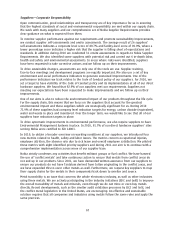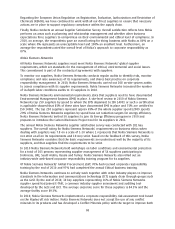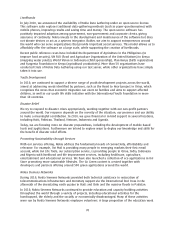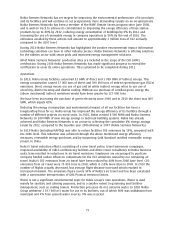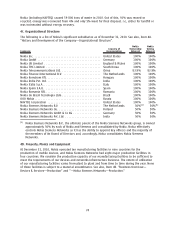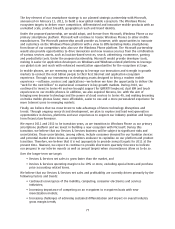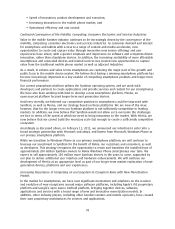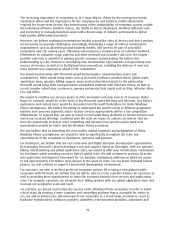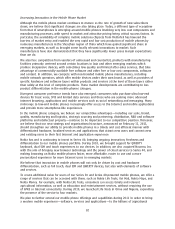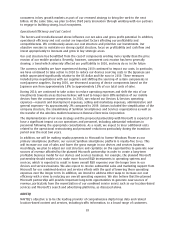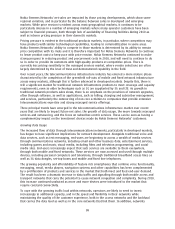Nokia 2010 Annual Report Download - page 78
Download and view the complete annual report
Please find page 78 of the 2010 Nokia annual report below. You can navigate through the pages in the report by either clicking on the pages listed below, or by using the keyword search tool below to find specific information within the annual report.The key element of our smartphone strategy is our planned strategic partnership with Microsoft,
announced on February 11, 2011, to build a new global mobile ecosystem. The Windows Phone
ecosystem targets to deliver more competitive, differentiated and innovative mobile products with an
unrivalled scale, product breadth, geographical reach and brand identity.
Under the proposed partnership, we would adopt, and license from Microsoft, Windows Phone as our
primary smartphone platform. Microsoft will continue to license Windows Phones to other mobile
manufacturers. The Microsoft partnership would provide us, however, with opportunities to innovate
and customize on the Windows Phone platform with a view to differentiating Nokia smartphones
from those of our competitors who also use the Windows Phone platform. The Microsoft partnership
would also provide opportunities to drive innovation and new revenue sources from the combination
of various services assets, such as locationbased services, search, advertising, ecommerce, gaming
and productivity tools. Under the proposed partnership, Microsoft would provide developer tools,
making it easier for application developers on Windows and Windowsrelated platforms to leverage
our global scale and reach with enhanced monetization opportunities for the ecosystem at large.
In mobile phones, we are renewing our strategy to leverage our innovation and strength in growth
markets to connect the next billion people to their first Internet and application ecosystem
experience. Through our investments in developing assets designed to bring a modern mobile
experience —software, services and applications—we believe we have the opportunity to deliver the
“web for the next billion” to aspirational consumers in key growth markets. During 2010, we
continued to invest in Series40 and we brought support for QWERTY keyboard, dual SIM and touch
experiences to our mobile phones. In addition, we also acquired Novarra, Inc. with the aim of
bringing new browser technology and the power of cloud services to Series 40, and making browsing
on Nokia mobile phones faster, more affordable, easier to use and a more personalized experience for
more Internet users in emerging markets.
Finally, we believe that we must invest to take advantage of future technology disruptions and
trends. Through ongoing research and development, we plan to explore and lead nextgeneration
opportunities in devices, platforms and user experiences to support our industry position and longer
term financial performance.
We expect 2011 and 2012 to be transition years, as we transition to Windows Phone as our primary
smartphone platform and we invest in building a new ecosystem with Microsoft. During this
transition, we believe that our Devices & Services business will be subject to significant risks and
uncertainties. Those uncertainties, among others, include consumer demand for our Symbian devices
and potential market share losses as competitors endeavor to capitalize on our platform and product
transition. Therefore, we believe that it is not appropriate to provide annual targets for 2011 at the
present time. However, we expect to continue to provide shortterm quarterly forecasts to indicate
our progress in our interim reports as well as annual targets when circumstances allow us to do so.
Over the longerterm we target:
• Devices & Services net sales to grow faster than the market, and
• Devices & Services operating margin to be 10% or more, excluding special items and purchase
price accounting related items.
We believe that our Devices & Services net sales and profitability are currently driven primarily by the
following factors and trends:
• Continued convergence of the mobility, computing, consumer electronics and services
industries;
• Increasing importance of competing on an ecosystem to ecosystem basis with new
monetization models;
• Increasing challenges of achieving sustained differentiation and impact on overall industry
gross margin trends;
77


